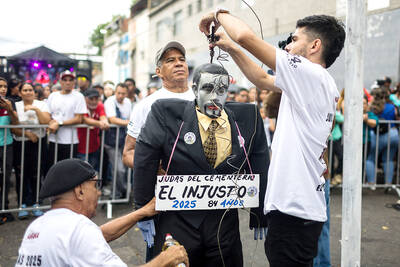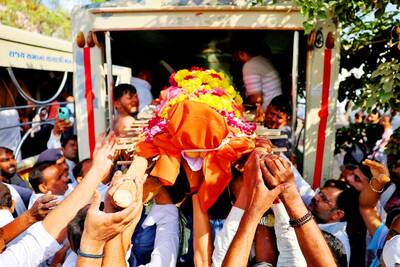A new generation of parades is hitting the streets of New Orleans for Mardi Gras and they are throwing away the old traditions of big, glitzy floats, and celebrity kings and queens, for smaller, greener and sometimes naughtier floats with a hipster sensibility.
These smaller krewes, as the parades or marching groups are called, draw on the talents of local artists and satirize everything from politics to local customs.
One float, titled “Benz Over,” spoofed the recent sale of naming rights for the Superdome to Mercedes-Benz. The float carried a small replica of the Dome with large buttocks for a roof. Another krewe’s floats are set atop people-powered adult tricycles fashioned from material salvaged after Hurricane Katrina.
A group called Krewe du Vieux chose “Crimes Against Nature” as its theme and when it hit the streets recently as carnival season got under way, there was no doubt this was not the usual Mardi Gras parade. One of its floats made fun of surgical procedures used to “improve” on nature with a giant pair of inflatable breasts rising and falling throughout the parade, and instead of handing out traditional beads, some of the scantily clad krewe members handed out condoms.
However, even though they are infusing the carnival parades with new ideas, in some ways the alternative krewes are drawing on very old Mardi Gras traditions that predate the era of automobiles and motorized floats. Krewe du Vieux uses mules, or sometimes bicycles, to draw its 17 small floats, which are built on boat trailers no more than 2.5m long and 3.6m high. Krewe members also march with their floats rather than riding on them and each float is accompanied by a New Orleans brass band.
Compare that with some of New Orleans’ biggest and best-known mainstream parades, where the floats might be 15m long and 5.5m high, carrying dozens of riders. Some massive floats — like the raucous Bacchus parade’s Baccagator float, a giant alligator, 33.5m long — can hold more than 100 riders.
The alternative krewes see Mardi Gras as a chance for individuals to exercise their creativity and engage in satire.
“The coolest thing is that people do it just to do it,” said Jim Gelarden, a member of Krewe du Vieux. “It’s just for fun. There is no social status at stake.”
Smaller groups get regular parade permits, rather than Mardi Gras permits, officer Ross Bourgeois of the New Orleans Police Department said.
This allows them more leeway in what they can do and where they can go. The regular Mardi Gras parades are so big they are no longer allowed to roll through the narrow streets of the French Quarter, but smaller groups can still navigate the city’s oldest and most famous neighborhood.
“These are groups that fly way under the radar,” said Arthur Hardy, a Mardi Gras historian and publisher of a Mardi Gras guide. “They don’t have to follow the rules the bigger groups do. They are free to be a bit on the bawdy side, and to do very new and striking things.”
Mardi Gras always falls on the Tuesday before Ash Wednesday. Many parties, balls and parades large and small are held for several weeks before the holiday, which this year falls on Feb. 21, and the streets are typically packed with revelers to watch the biggest parades roll the weekend before. These traditional parades offer glittering spectacles, as well as a chance to scramble for “throws,” as the beads, doubloon coins and other items tossed to the crowds are called.
The smaller groups, in contrast, offer spectators a different, more intimate experience.
“I love the offbeat parades,” said Mary Ann Gautraeux, who said she tries to take in as many as she can each year. “The people in the parade are right there with the crowd. It makes you feel so much more a part of everything.”
The number of groups that stage small parades, or who march before or during one of the bigger parades, is growing, as are their memberships, said Ann Marie Coviello, a member of a krewe called Box of Wine.
“We started out as just a few people walking down St Charles [Avenue],” Coviello said. “Now we have a real parade because our membership has grown so much.”
Smaller groups also appeal to New Orleans’ artists’ community, allowing them to participate in ways that are not possible with the larger parades, said Karina Nathan, from the Krewe of Kolossos.
“We hope to see more people use our local artists, especially for throws, instead of getting the ones made in China,” she said. “We would like Mardi Gras to be greener.”
Kolossos uses recycled materials to build its small floats, which are mounted on adult tricycles rescued from Hurricane Katrina debris. Their costumes and even the throws they produce are all made from recycled material.
One krewe carries smallness to extremes. Its 25 floats, no bigger than large shoe boxes on wheels, will be pulled through the streets by krewe members in formal attire, who also hand out handmade throws. The small, but elaborate floats are well-crafted takes on traditional Carnival floats. Some carry Barbie dolls dressed up as royalty and many are decorated with tiny Christmas lights.
As with other alternative groups, their membership has also grown. Jeremy Yuslum, one of the founders, thinks that is partly because of Hurricane Katrina, which almost destroyed the city in 2005.
“I think that people who stayed through the storm, or left and came back, feel a much stronger allegiance to our traditions,” Yuslum said. “I think people have taken a new look at the city and what we have here.”

POLITICAL PRISONERS VS DEPORTEES: Venezuela’s prosecutor’s office slammed the call by El Salvador’s leader, accusing him of crimes against humanity Salvadoran President Nayib Bukele on Sunday proposed carrying out a prisoner swap with Venezuela, suggesting he would exchange Venezuelan deportees from the US his government has kept imprisoned for what he called “political prisoners” in Venezuela. In a post on X, directed at Venezuelan President Nicolas Maduro, Bukele listed off a number of family members of high-level opposition figures in Venezuela, journalists and activists detained during the South American government’s electoral crackdown last year. “The only reason they are imprisoned is for having opposed you and your electoral fraud,” he wrote to Maduro. “However, I want to propose a humanitarian agreement that

ECONOMIC WORRIES: The ruling PAP faces voters amid concerns that the city-state faces the possibility of a recession and job losses amid Washington’s tariffs Singapore yesterday finalized contestants for its general election on Saturday next week, with the ruling People’s Action Party (PAP) fielding 32 new candidates in the biggest refresh of the party that has ruled the city-state since independence in 1965. The move follows a pledge by Singaporean Prime Minister Lawrence Wong (黃循財), who took office last year and assumed the PAP leadership, to “bring in new blood, new ideas and new energy” to steer the country of 6 million people. His latest shake-up beats that of predecessors Lee Hsien Loong (李顯龍) and Goh Chok Tong (吳作棟), who replaced 24 and 11 politicians respectively

Young women standing idly around a park in Tokyo’s west suggest that a giant statue of Godzilla is not the only attraction for a record number of foreign tourists. Their faces lit by the cold glow of their phones, the women lining Okubo Park are evidence that sex tourism has developed as a dark flipside to the bustling Kabukicho nightlife district. Increasing numbers of foreign men are flocking to the area after seeing videos on social media. One of the women said that the area near Kabukicho, where Godzilla rumbles and belches smoke atop a cinema, has become a “real

‘WATER WARFARE’: A Pakistani official called India’s suspension of a 65-year-old treaty on the sharing of waters from the Indus River ‘a cowardly, illegal move’ Pakistan yesterday canceled visas for Indian nationals, closed its airspace for all Indian-owned or operated airlines, and suspended all trade with India, including to and from any third country. The retaliatory measures follow India’s decision to suspend visas for Pakistani nationals in the aftermath of a deadly attack by shooters in Kashmir that killed 26 people, mostly tourists. The rare attack on civilians shocked and outraged India and prompted calls for action against their country’s archenemy, Pakistan. New Delhi did not publicly produce evidence connecting the attack to its neighbor, but said it had “cross-border” links to Pakistan. Pakistan denied any connection to